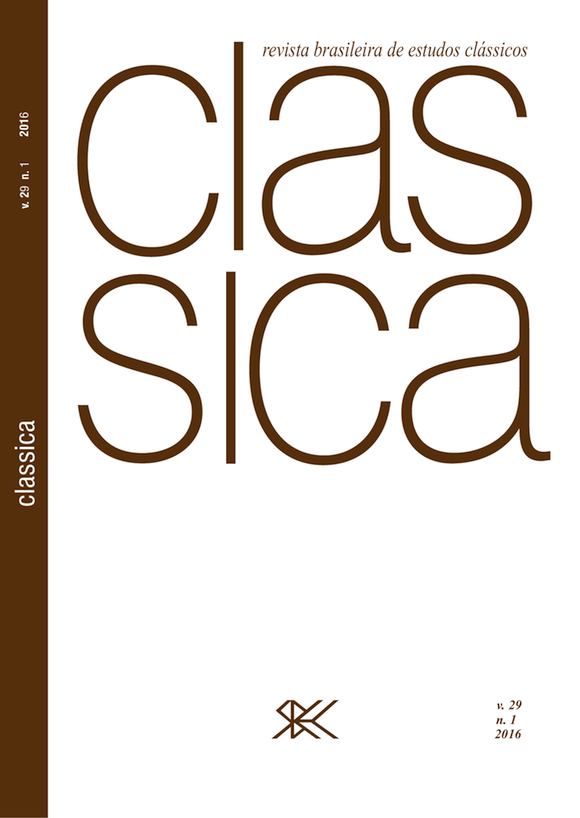Odysseus and the Cult of Apollo at Delos
DOI:
https://doi.org/10.24277/classica.v29i1.411Palavras-chave:
Apollo, Delos, Greek religion, material culture, Odyssey.Resumo
This paper explores literary representations of the cult of Apollo on Delos. This island is, to be sure, mentioned only occasionally in early Greek poetry, but details specific to the cult do appear. Thus, for example, Odysseus describes a palm tree he saw at an altar of Apollo on Delos (Od. 6.162-3), and a third-century inscription from the island mentions just such a feature. References to a palm, altar, and temple at Delos in later classical authors, including Callimachus, Pliny, Cicero, and Plutarch, demonstrate that the Archaic period traditions represented by the Homeric passages continued to shape how successive generations of visitors understood Delos. The material record makes clear that the Greek epic tradition documents a time when Delos was already a well attended sanctuary, and that later constructions at the site attempted to remain consistent with the details preserved in the epics.
Downloads
Referências
AHL, Frederick. Amber, Avallon, and Apollo’s Singing Swan. American Journal of Philology, v. 103, n. 4, p. 373-411, 1982.
BETHE, Erich. Das Archaische Delos und sein Letoon. Hermes, v. 72, n. 2, p. 199-201, 1937.
BRUNEAU, Philippe; FRAISSE, Philippe. Le monument à Abside et la question de l’Autel de cornes. Exploration archéologique de Délos. Fascicule XL. École Française d’Athènes, 2002.
BRUNEAU, Philippe. Recherches sur les Cultes de Délos a l’Epoque Hellénistique et a l’Epoque Impériale. Paris: Éditions de Boccard, 1970.
BRUNEAU, Philippe; DUCAT, Jean. Guide de Délos. Paris: Éditions de Boccard, 1965.
BURNS, Alfred. The Chorus of Ariadne. Classical Journal, v.70, n. 2, p. 1-12, 1974.
COLDSTREAM, John Nicolas. Geometric Greece: 900-700 BC. London: Routledge, 2003 [1977].
CONSTANTAKOPOULOU, Christy. The Dance of the Islands: Insularity, Networks, the Athenian Empire and the Aegean World. Oxford: Oxford University Press, 2007.
CRIELAARD, Jan. Homer, History and Archaeology: Some Remarks on the Date of the Homeric World. In: CRIELAARD, J. (ed.). Homeric Questions. Amsterdam, 1995, p. 201-88.
DANEK, Georg. Epos und Zitat: Studien zu den Quellen der Odyssee. Vienna, 1998.
DEN ADEL, Raymond. Apollo’s Prophecies at Delos. Classical World, v. 76, n.5, p. 288-90, 1983.
HARDER, R. Nausikaa und die Palme von Delos. Gymnasium, v. 95, p. 505-16, 1988.
MAZARAKIS AINIAN, Alexander. From Rulers’ Dwellings to Temples: Architecture, Religion and Society in Early Iron Age Greece (c. 1100- 700 B.C.). Studies in Mediterranean Archaeology, v. CXXI. Jonsered: Paul Åströms förlag, 1997.
MORGAN, Catherine. Athletes and Oracles: the Transformation of Olympia and Delphi in the eighth century BC. Cambridge: Cambridge University Press, 1990.
NAGY, Gregory. Homer the Preclassic. Berkeley; Los Angeles CA: University of California Press, 2010.
SCHACHTER, Albert. Cults of Boiotia, v. 1. Acheloos to Hera. Bulletin of the Institute of Classical Studies, London, Institute of Classical Studies, v. 28, suppl. 38-1, 1981.
SNODGRASS, Anthony. Archaic Greece: the Age of Experiment. Berkeley CA: University of California Press, 1980.
SOURVINOU-INWOOD, Christiane. Due protettrici della donna a Locri Epizefirii: Persefone e Afrodite. In: ARRIGONI, Giampiera (a cura di). Le donne in Grecia. Roma-Bari: Laterza, 1985, p. 203-221.
TSAGALIS, Christos. The Oral Palimpsest: Exploring Intertextuality in the Homeric Epics. Cambridge MA: Harvard University Press, 2008.
WEST, Martin. The Contest of Homer and Hesiod. Classical Quarterly New Series, v. 17, n. 2, p. 433-50, 1967.
Downloads
Publicado
Edição
Seção
Licença
Autores que publicam nesta revista concordam com os seguintes termos:
a. Autores mantém os direitos autorais e concedem à revista o direito de primeira publicação, com o trabalho simultaneamente licenciado sob a Creative Commons Atribuição 4.0 Internacional (CC BY 4.0) que permite o compartilhamento do trabalho com reconhecimento da autoria e publicação inicial nesta revista.
b. Autores têm autorização para assumir contratos adicionais separadamente, para distribuição não-exclusiva da versão do trabalho publicada nesta revista (ex.: publicar em repositório institucional ou como capítulo de livro), com reconhecimento de autoria e publicação inicial nesta revista.
c. Autores têm permissão e são estimulados a publicar e distribuir seu trabalho online após o processo editorial (ex.: em repositórios institucionais ou na sua página pessoal), já que isso pode gerar alterações produtivas, bem como aumentar o impacto e a citação do trabalho publicado (Veja O Efeito do Acesso Livre).
d. Autores autorizam a cessão, após a publicação, de seu conteúdo para reprodução em indexadores de conteúdo, bibliotecas virtuais, bases de dados de acesso público e similares.











